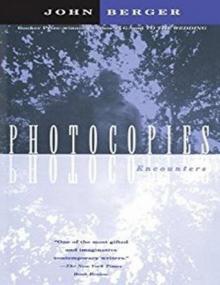- Home
- John Berger
The Success and Failure of Picasso
The Success and Failure of Picasso Read online
FIRST VINTAGE INTERNATIONAL EDITION, DECEMBER 1993
Copyright © 1965, 1989 by John Berger
All rights reserved under International and Pan-American Copyright Conventions. Published in the United States by Vintage Books, a division of Random House, Inc., New York, and simultaneously in Canada by Random House of Canada Limited, Toronto. Originally published in Great Britain and the United States by Penguin Books in 1965 and 1966. Reprinted in 1980 by Pantheon Books, a division of Random House, Inc., New York.
Grateful acknowledgment is made to Macmillan Publishing Company and A.P. Watt Ltd. for permission to reprint “The Spur” from Collected Poems of W.B. Yeats. Copyright 1940 by Georgie Yeats, renewed 1968 by Bertha Georgie Yeats, Michael Butler Yeats, and Anne Yeats; “Crazy Jane on the Day of Judgment,” and “Crazy Jane Talks with the Bishop” from Collected Poems of W.B. Yeats. Copyright 1933 by Macmillan Publishing Company, renewed 1961 by Bertha Georgie Yeats. Rights outside the U.S. administered by A.P. Watt Ltd. on behalf of Michael B. Yeats and Macmillan London Ltd.
Chapter 3, “A Last Tribute,” first appeared under the title “An Old Man’s Frenzy” in Art International, issue no. 3, Summer 1988, pp. 21-30.
Library of Congress Cataloging-in-Publication Data
Berger, John.
The success and failure of Picasso/John Berger.
– 1st Vintage International ed.
p. cm.
Originally published: New York: Pantheon Books, 1989.
eISBN: 978-0-307-79424-6
1. Picasso, Pablo, 1881–1973–Criticism and interpretation.
I. Title.
ND553.P5B45 1993
709’.2–dc20 93-13121
v3.1
I dedicate this book to my Anya, to Ernst Fischer, and to the memory of Max Raphael,1 a forgotten but great critic. The three of them persuaded me.
* * *
1 Proudhon, Marx, Picasso (Excelsior Press, Paris, 1933).
Contents
Cover
Title Page
Copyright
Dedication
Acknowledgments
List of Illustrations
Preface
1. Picasso
2. The Painter
3. A Last Tribute
Index
About the Author
Other Books by This Author
I would like to acknowledge the help of Tony Richardson throughout all stages of the production of this book – and especially for all his work in the tracing and collecting of the plates.
J.B.
The publisher gratefully acknowledges the Artists Rights Society, Inc., for permission to reproduce the work of Pablo Picasso, Roger de la Fresnaye, Juan Gris, and Fernand Léger (all copyright ARS N.Y./SPADEM, 1988) and that of Georges Braque, Robert Delaunay, and Constantin Brancusi (copyright ARS N.Y./ADAGP, 1988). For their help in supplying specific photographs, we are indebted as follows: to Studio Alfieri for illustration 14; to Mariette Lachaud for 17; to the Arts Council for 18, 23, 42, 99, 100, and 106; to Giraudon for 52 and 66; to Éditions Cercle d’Art for 68; to Jean Mohr for 91; and to Galerie Louise Leiris for 103, 105, and 107–20. The remaining photographs have been obtained from the institutions and individuals acknowledged in the list of illustrations.
ILLUSTRATIONS
a. Picasso: Self-Portrait, autumn 1906 (Musée Picasso, Paris)
1 Château de Boisgeloup, Normandy
2 Picasso and Françoise Gilot at Golfe Juan, 1948 (photo: Robert Capa)
3 Picasso: An Old Man, 1895 (private collection)
4 Spanish landscape (photo: Jean Mohr)
5 Spanish peasants harvesting peppers (photo: Jean Mohr)
6 Easter procession in Lorca (photo: Jean Mohr)
7 Spanish peasants returning from market (photo: Jean Mohr)
8 Barcelona, Las Ramblas (photo: Jean Mohr)
9 Picasso: Head of a Horse, 1937 (on extended loan to the Museum of Modern Art, New York, from the artist)
10 Rubens: Christ Crucified Between Two Thieves, 1620 (Antwerp)
11 Picasso: Portrait of Artist’s Father, 1895
12 Picasso: Portrait of Artist’s Mother, 1895
13 Picasso: The Coiffure, 1954 (Rosengart collection)
14 Picasso: Jacqueline with Black Scarf, 1954 (private collection)
15 Picasso: Seated Woman, 1955 (Rosengart collection)
16 Braque: Studio, VIII, 1954–55 (Douglas Cooper collection)
17 Braque: The Bird and Its Nest, 1955–56
18 Picasso: Self-Portrait, 1901 (private collection)
19 Picasso: The Frugal Meal, 1904
20 Picasso: Clown with a Glass (self-portrait), 1905 (private collection)
21 Picasso: Family of Saltimbanques, 1905 (National Gallery of Art, Washington, D.C., Chester Dale collection)
22 Picasso: Acrobat’s Family with Ape, 1905 (Gothenburg Art Gallery)
23 Picasso: Still-life with Chair-caning, 1912 (private collection)
24 Fra Angelico: The Vocation of St Nicholas (detail), 1437 (Vatican Museum)
25 Picasso: The Fruit-dish, 1912 (private collection)
26 Courbet: Les Demoiselles des bords de la Seine, 1856 (Petit Palais, Paris)
27 Courbet: The Pond, 1860s (Kunsthistorisches Museum, Vienna)
28 Poussin: Orpheus and Eurydice, 1650 (Louvre, Paris)
29 Cézanne: Trees by the Water, 1900–04 (private collection)
30 Braque: Bottle, Glass, and Pipe, 1913 (Lady Hulton collection)
31 Picasso: Portrait of Monsieur Kahnweiler, 1910 (courtesy of the Art Institute of Chicago)
32 Gris: Portrait of Picasso, 1911–12 (courtesy of the Art Institute of Chicago. Gift of Leigh Block)
33 Robert Delaunay: The Eiffel Tower, 1910 (Guggenheim Museum, New York)
34 Roger de la Fresnaye: Conquest of the Air, 1913 (Museum of Modern Art, New York, Mrs Simon Guggenheim Fund)
35 Carlo Carra: The Funeral of the Anarchist Galli, 1911 (Museum of Modern Art, New York, Lillie P. Bliss Bequest)
36 Picasso: Les Demoiselles d’Avignon, 1907 (Museum of Modern Art, New York, Lillie P. Bliss Bequest)
37 Cézanne: Les Grandes Baigneuses, 1898–1906 (Philadelphia Museum of Art)
38 Picasso: Les Demoiselles d’Avignon, 1907 (Museum of Modern Art, New York, Lillie P. Bliss Bequest)
39 Braque: Nude, 1907–8 (Madame Cuttoli collection)
40 Picasso: Landscape with Bridge, 1908 (National Gallery, Prague)
41 Braque: Houses at Estaque, 1908 (Rupf Foundation, Berne)
42 Picasso: Girl with a Mandolin, 1910 (private collection, New York)
43 Braque: Girl with a Mandolin, 1910 (private collection)
44 Picasso: The Violin, 1913 (Philadelphia Museum of Art)
45 Picasso: Curtain for Parade, 1917 (Musée National d’Art Moderne, Paris)
46 Gris: The Violin, 1915 (Kunstmuseum, Basle)
47 Picasso: Olga Picasso in an Arm-chair, 1917 (private collection)
48 Picasso: Bathers, 1921
49 Picasso as a matador, 1924 (photo: Man Ray)
50 Ingres: Drawing, 1828
51 Picasso: Madame Wildenstein, 1918 (Daniel Wildenstein collection)
52 Picasso: Women at the Fountain, 1921
53 Poussin: Eliezer and Rebecca (detail), 1648
54 Picasso: Bull’s Head, 1943
55 Picasso: Bull, Horse, and Female Matador, 1934
56 Picasso: Sitting Girl and Sleeping Minotaur, 1933
57 Schiele: Seated Male Nude (self-portrait), 1910
58 Picasso: Nude on a Black Couch, 1932 (Mrs Meric Gallery, Paris)
59 Poussin: The Triumph of Pan, 1638–9 (Louvre, Paris)
6
0 Picasso: Bacchanale, 1944 (private collection)
61 Picasso: The Mirror, 1932 (private collection)
62 Picasso: Weeping Head, 1937 (on extended loan to the Museum of Modern Art, New York, from the artist)
63 Picasso: Figure, 1939 (Othmar Huber collection, Glarus, Switzerland)
64 Picasso: Triptych, 1946 (Musée Grimaldi, Antibes)
65 Picasso: Joie de vivre, 1946 (Musée Grimaldi, Antibes)
66 Giovanni Bellini: The Feast of the Gods, 1514 (National Gallery of Art, Washington, D.C., Widener collection)
67 Picasso: Massacre in Korea, 1951
68 Picasso: Peace, 1952 (Temple de la Paix, Vallauris, France)
69 Titian: Shepherd and Nymph, c. 1570 (Kunsthistorisches Museum, Vienna)
70 Léger: Composition aux deux perroquets, 1935–9 (Musée National d’Art Moderne, Paris)
71 Delacroix: Horse Frightened by a Storm, 1824 (National Museum, Budapest)
72 Brancusi: The Bird, 1915 (Museum of Modern Art, New York)
73 Brancusi in his studio, 1946 (photo: Wayne Miller)
74 Picasso: Illustration to Aimé Césaire’s Corps perdu, 1950
75 Piero di Cosimo: The Immaculate Conception (Uffizi, Florence)
76 Piero di Cosimo: The Finding of Vulcan on Lemnos (Wadsworth Atheneum, Hartford, Connecticut)
77 Picasso: The Race, 1922 (private collection)
78 Picasso: Figure, 1927 (private collection)
79 Picasso: Woman in an Arm-chair, 1929 (private collection)
80 Picasso: Girls with a Toy Boat, 1937 (Peggy Guggenheim collection, Venice)
81 Picasso: Guernica (detail), 1937 (on extended loan to the Museum of Modern Art, New York, from the artist)
82 Picasso: Nude Dressing Her Hair, 1940 (Mrs Bertram Smith collection)
83 Picasso: Nude with a Musician, 1942 (Musée National d’Art Moderne, Paris)
84 Picasso: First Steps, 1943 (Yale University Art Gallery)
85 Picasso: Portrait of Mrs H.P., 1952 (private collection)
86 Van Gogh: Portrait of the Chief Superintendent of the Asylum at Saint-Remy, 1889 (Mrs Dübi-Müller collection)
87 Picasso: Nude on a Black Couch, 1932 (Mrs Meric Gallery, Paris)
88 Picasso: The Mirror, 1932 (private collection)
89 Picasso: Woman in a Red Arm-chair, 1932 (reproduced by courtesy of the Trustees of the Tate Gallery, London)
90 Picasso: Nude, 1933
91 Picasso: Head of Woman (bronze), 1931–2 (private collection)
92 Picasso: Sculptor and Model Resting, 1933
93 Picasso: Page of drawings, 1936
94 Picasso: Head of a Woman, 1943
95 Picasso: Young Girl and Minotaur, 1934–5
96 Picasso: Guernica, 1937 (on extended loan to the Museum of Modern Art, New York, from the artist)
97 Siqueiros: Echo of a Scream, 1937 (Museum of Modern Art, New York gift of Edward M. M. Warburg)
98 Picasso: Bull, Horse, and Female Matador, 1934
99 Picasso: Crying Woman, 1937
100 Picasso: Still-life with Bull’s Skull, 1942 (the estate of André Lefèvn collection)
101 Picasso: Dove (poster)
102 Delacroix: Les Femmes d’Alger, 1834 (Louvre, Paris)
103 Picasso: Les Femmes d’Alger, 1955
104 Velázquez: Las Meninas, 1656 (Museo del Prado, Madrid)
105 Picasso: Las Meninas, 1957
106 Picasso: Bullfight, 1934 (Victor W. Ganz collection)
107 Picasso: Nude and Old Clown, 21 December 1953
108 Picasso: Young Woman and Old Man with Mask, 23 December 1953
109 Picasso: Young Woman and Monkey, 3 January 1954
110 Picasso: Young Woman and Cupid with Mask, 5 January 1954
111 Picasso: Young Woman with Cupids, 5 January 1954
112 Picasso: Girl, Clown, Donkey, and Monkey, 10 January 1954
113 Picasso: Old Clown and Couple, 10 January 1954
114 Picasso: Couple with Masks, 24 January 1954
115 Picasso: Old Man and Young Woman with Masks, 25 January 1954
116 Picasso: Girl, Clown, Mask, and Monkey, 25 January 1954
117 Picasso: Painter and Model, 24 December 1953
118 Picasso: Painter and Model, 25 December 1953
119 Picasso: Woman, Apple, Monkey, Man, 26 January 1954
120 Picasso: Woman and Monkey Painting, 10 January 1954
121 Tintoretto: Woman with Bare Breasts (Museo del Prado, Madrid)
122 Giorgione: Old Woman, c. 1569 (Galleria dell’Accademia, Venice)
123 Titian: Vanity of the World, 1515 (Alte Pinakothek, Munich)
124 Picasso: Nu couché, 5 October 1972 (Musée Picasso, Paris)
PREFACE
I wrote this book more than twenty years ago. When it first came out, in 1965, it was attacked in many places, if not everywhere, as being insolent, insensitive, doctrinaire and perverse. In England, the land of Gentlemen, it was also dismissed as being in bad taste. Picasso was still alive and at the height of his fame. Hagiographic books and articles came out every year. The critical response to my book somewhat surprised me. I thought I had written an essay informed by sympathy for the artist and the man it concerned. Perhaps now, with the passing of the years, this sympathy for the protagonist of the story I tell is more evident.
For example, the essay begins by discussing Picasso’s wealth, a beginning which was, at the time, considered vulgar and tasteless. To translate the sums of money I mention into current currency, one should multiply by at least ten. Then Picasso died. Soon afterwards, the internecine litigations concerning his estate began. More recently, one has witnessed similarly sordid affairs following the deaths of other artists: Salvador Dali, for instance. So long as works of art are primarily objects of spectacular investment, such situations are bound to occur. The point, however, is that the alienation which this implies is usually first suffered as a solitude (the solitude of the bank vault) by the ageing artist. This solitude was the starting point of my essay, and as I re-read it, I find that time has also confirmed many other points I made.
There is, however, an omission. When writing this book I failed to give enough importance to certain typical works which Picasso painted between 1902 and 1907. To put it simply, I was too impatient to arrive at the moment of Cubism. In failing to give enough attention to this early period, I missed, I think, a clue about Picasso’s essential nature as an artist. I felt the nature of his genius, I talked around it, but I failed to formulate it well enough. Perhaps I can make good this omission.
a.Picasso. Self-Portrait. 1906
Painting is the art which reminds us that time and the visible come into being together, as a pair. The place of their coming into being is the human mind, which can coordinate events into a time sequence and appearances into a world seen. With this coming into being of time and the visible, a dialogue between presence and absence begins. We all live this dialogue.
Consider Picasso’s Self-Portrait, of 1906. What is happening in this painting? Why can this apparently uneventful image move us so deeply?
The young man’s expression – not untypical for a man of twenty-five – is solitary, attentive, and searching. It is an expression in which loss and waiting combine. Yet, this is at the level of literature.
What is happening plastically? The head and body are pressing towards the visible, are searching for a perceptible form, and have not fully found it. They are just at the point of finding it, of alighting on it – like a bird on a roof. The image is moving because it represents a presence striving to become seen.
Metaphorically speaking, this is a fairly common experience. What is extraordinary is that Picasso here finds (stumbles upon but somehow recognises) the painterly means necessary to express this tentative but almost desperately urgent coming-into-visibility. Between 1902 and 1907, the years leading up to the Demoiselles d’Avignon and including the first proto-Cubist works, he painted and drew numerous images which express the first hope o
f a settlement with the visible: a settlement which offers an assurance – an assurance which just before seemed impossible – of being seen.
In the self-portrait, there are pictorial devices which aid the expression of this just-coming-into-visibility: the way that the flesh-coloured pigment spills over the outlines; the minimal, unfinished painting of the shadows; the lines of the facial features, painted on rather than into the face – like figures painted on a vase. (‘He is like Adam the instant after he was created and before he drew his first breath.’)
In other paintings of the same period he used other devices. I doubt whether his use of them was conscious. The means used were engendered by a profound intuitive conviction, a conviction which lay at the heart of Picasso’s activity as a painter. Picasso did not accept visual reality as innate and inevitable. On the contrary, he was always aware that anything he saw might have taken a different form, that behind what is visible lie a hundred other unchosen visible possibilities.
Chosen or unchosen by whom? Not, of course, by the artist, nor by the presence seeking visual form, nor, in fact, by God during the days of creation. The question has to remain unanswered, but it was in the hope of coming closer to some answer that Picasso, in face of the visible, was always to go on playing with the possibly visible, before the visible, as we know it, has been assured. His demonic drive for invention, sometimes profound and sometimes superficial, derived from this fundamental conviction that, in origin, the visible is arbitrary.
Intuitively he separated the energy of growth from the existent. And this separation allowed him to play with the enigma of the preexistent. Another way of describing the poignancy of the 1906 self-portrait would be to say that it is an image of preexistence, a portrait which is about to give birth to its subject.
I try to make clear in words what can only be said or questioned clearly by the pictorial. Picasso’s questioning or quest did not, however, simply depend upon the experience of art. It was grounded in other, much wider human experiences, especially those in which the energy of the body surpasses the normal dispositions of the physical. This is why Picasso was so haunted by, and was so capable of creating, images of passion and of pain: images in which energy surpasses the existent, images which reveal how the existent, and its dispositions, which we take for granted, is never complete or finished.

 Once in Europa
Once in Europa To the Wedding
To the Wedding The Shape of a Pocket
The Shape of a Pocket Here Is Where We Meet
Here Is Where We Meet The Success and Failure of Picasso
The Success and Failure of Picasso G.
G. Photocopies: Encounters
Photocopies: Encounters A Fortunate Man: The Story of a Country Doctor
A Fortunate Man: The Story of a Country Doctor And Our Faces, My Heart, Brief as Photos
And Our Faces, My Heart, Brief as Photos Titian
Titian A Fortunate Man
A Fortunate Man Photocopies: Encounters (Vintage International)
Photocopies: Encounters (Vintage International) Selected Essays of John Berger
Selected Essays of John Berger